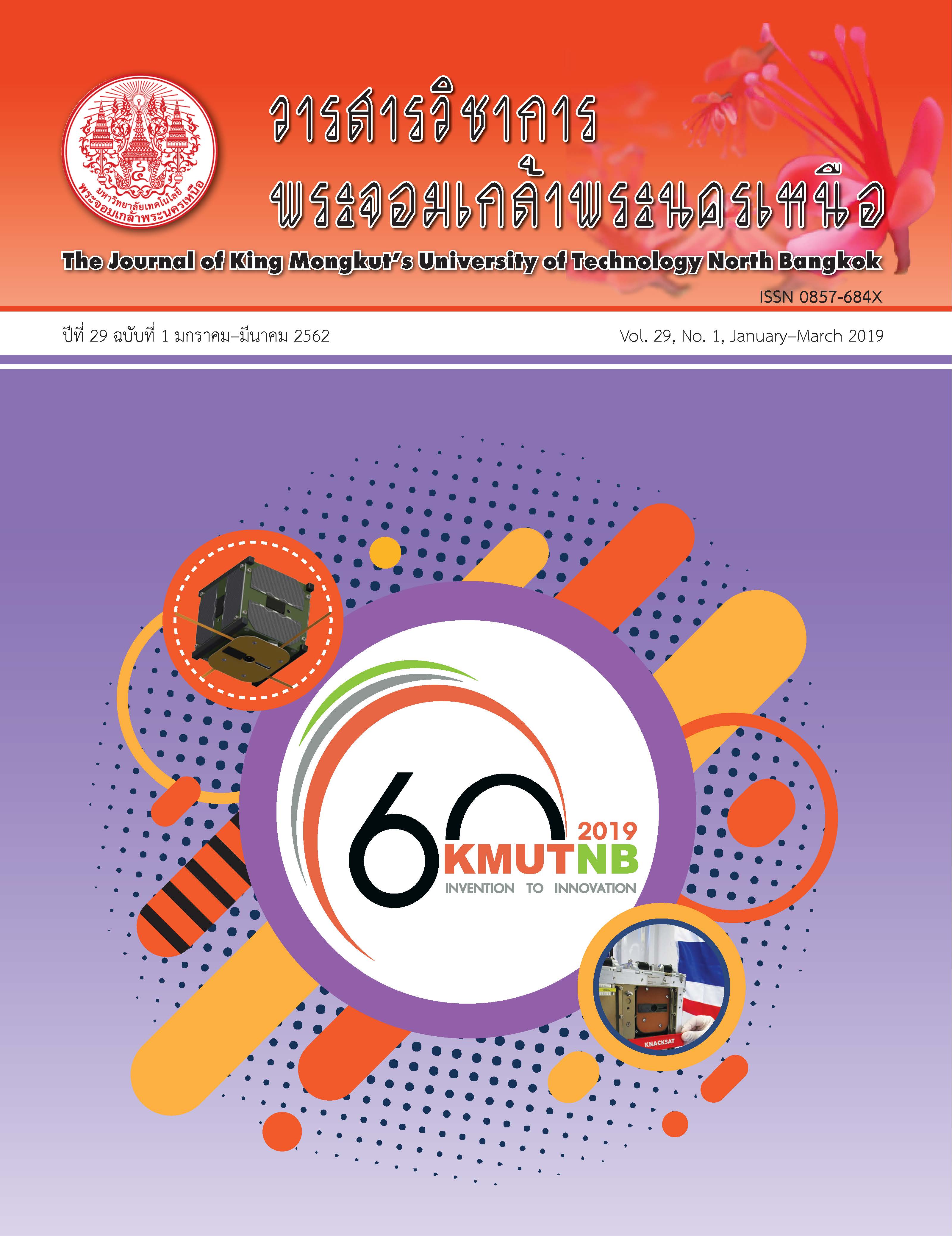ผลของเถ้าถ่านหินต่อการแทรกซึมคลอไรด์และกำลังอัดของคอนกรีตที่ใช้มวลรวมจากเศษคอนกรีตและมวลรวมธรรมชาติภายใต้สิ่งแวดล้อมทะเลเป็นเวลา 5 ปี
Main Article Content
บทคัดย่อ
งานวิจัยนี้ศึกษาผลของเถ้าถ่านหินต่อสัมประสิทธิ์การแทรกซึมของคลอไรด์ และกำลังอัดของคอนกรีตที่ใช้มวลรวมจากเศษคอนกรีต และมวลรวมจากธรรมชาติภายใต้สภาวะแวดล้อมทะเลเป็นเวลา 5 ปี โดยใช้เถ้าถ่านหินจากแม่เมาะแทนที่ปูนซีเมนต์ปอร์ตแลนด์ประเภทที่ 1 ในคอนกรีตที่ใช้มวลรวมจากเศษคอนกรีตและมวลรวมจากธรรมชาติในอัตราส่วนร้อยละ 0, 15, 25, 35 และ 50 โดยน้ำหนักวัสดุประสาน และใช้อัตราส่วนน้ำต่อวัสดุประสาน (W/B) เท่ากับ 0.40 และ 0.45 สำหรับมวลรวมจากเศษคอนกรีต และ 0.45 สำหรับมวลรวมจากธรรมชาติ หล่อตัวอย่างคอนกรีตทรงลูกบาศก์ขนาด200×200×200 มม.3 สำหรับทดสอบการแทรกซึมคลอไรด์และกำลังอัดของคอนกรีต หลังจากบ่มคอนกรีตในน้ำเป็นเวลา28 วัน นำตัวอย่างทดสอบไปแช่ในสิ่งแวดล้อมทะเลบริเวณชายฝั่งในสภาวะเปียกสลับแห้ง โดยเก็บตัวอย่างทดสอบการแทรกซึมของคลอไรด์ทั้งหมด และกำลังอัดของคอนกรีตที่อายุแช่น้ำทะเล 5 ปี ผลการศึกษาพบว่า คอนกรีตที่ใช้มวลรวมจากเศษคอนกรีตทุกส่วนผสม มีการสูญเสียกำลังอัดหลังแช่น้ำทะเลเป็นเวลา 5 ปี ส่วนกลุ่มที่ใช้มวลรวมจากธรรมชาติที่ผสมเถ้าถ่านหินทุกส่วนผสม มีกำลังอัดหลังแช่น้ำทะเลที่อายุ 5 ปี เพิ่มขึ้นจากอายุบ่ม 28 วัน การใช้เถ้าถ่านหินแทนที่ปูนซีเมนต์ปอร์ตแลนด์ประเภทที่ 1 ในปริมาณที่สูงขึ้น ส่งผลต่อการลดสัมประสิทธิ์การแทรกซึมของคลอไรด์ในคอนกรีตลงได้อย่างชัดเจนซึ่งให้ผลไปในทิศทางเดียวกันทั้งกลุ่มที่ใช้มวลรวมจากธรรมชาติและมวลรวมจากเศษคอนกรีต โดยพบว่า คอนกรีตที่ใช้มวลรวมจากเศษคอนกรีตที่ผสมเถ้าถ่านหินอย่างน้อยร้อยละ 15 โดยน้ำหนักวัสดุประสาน ให้สัมประสิทธิ์การแทรกซึมของคลอไรด์ต่ำกว่าคอนกรีตธรรมดาที่ใช้มวลรวมจากธรรมชาติ ซึ่งมีอัตราส่วนน้ำต่อวัสดุประสานเท่ากับ 0.45
Article Details
บทความที่ลงตีพิมพ์เป็นข้อคิดเห็นของผู้เขียนเท่านั้น
ผู้เขียนจะต้องเป็นผู้รับผิดชอบต่อผลทางกฎหมายใดๆ ที่อาจเกิดขึ้นจากบทความนั้น
เอกสารอ้างอิง
[2] A. K. Saha, “Effect of class F fly ash on the durability properties of concrete,” Sustainable Environment Research, vol. 28, no. 1, pp. 25–31, 2018.
[3] C. H. Huang, S. K. Lin, C. S. Chang, and H. J. Chen, “Mix proportions and mechanical properties of concrete containing very high-volume of Class F fly ash,” Construction and Building Materials, vol. 46, no. 3, pp. 71–78, 2013.
[4] EG. Moffatt, MDA. Thomas, and A. Fahiml, “Performance of high-volume fly ash concrete in marine environment,” Cement and Concrete Research, vol. 102, pp. 127–135, 2017.
[5] R. Somna, C. Jaturapitakkul, P. Rattanachu, and W. Chalee, “Effect of ground bagasse ash on mechanical and durability properties of recycled aggregate concrete,” Materials and Design, vol. 36, pp. 597–603, 2012.
[6] M. Etxeberria, E. Vazquez, E. Mari, and M. Barra, “Influence of amount of recycled coarse aggregates and production process on properties of recycled aggregate concrete,” Cement and Concrete Research, vol. 37, no. 5, pp. 735–742, 2012.
[7] SC. Kou, KC. Poon, and D. Chan, “Influence of fly ash as cement replacement on the properties of recycled aggregate concrete,” ASCE’s Journal of Materials in Civil Engineering, vol. 19, no. 9, pp. 16–22, 2007.
[8] R. Somna, C. Jaturapitakkul, W. Chalee, and P. Rattanachu, “Effect of W/B ratio and ground fly ash on properties of recycled aggregate,” Journal of Materials in Civil Engineering, vol. 24, no. 1, pp. 16–22, 2012.
[9] N. Butchueathai, T. Cheewaket, and W. Chalee, “Chloride diffusion coefficient of recycled aggregate concretes containing fly ash under 3-year exposure in marine environment” The Journal of KMUTNB, vol. 27, no. 3, pp. 441–451, 2017 (in Thai).
[10] ACI Guide to durable concrete, American Concrete Institute ACI Committee 201.2R-01, 2003.
[11] ASTM Standard specification for coal fly ash and raw or calcined natural pozzolan for use in concrete, Annual Book of ASTM Standards C618-03, 2003.
[12] ASTM Standard test method for acid-soluble chloride in mortar and concrete, Annual Book of ASTM Standards C 1152, 2008.
[13] W. Chalee and C. Jaturapitakkul, “Effect of W/B ratios and fly ash finenesses on chloride diffusion coefficient of concrete in marine environment,” Materials and Structures, vol. 42, no. 4, pp. 505–515, 2009.
[14] A. M. Rashad, “A brief on high-volume class F fly ash as cement replacement – A guide for civil engineer,” International Journal of Sustainable Built Environment, vol. 4, pp. 278–306, 2015.
[15] P. Chindaprasirt and C. Jaturapitakkul, “Cement, pozzolan and concrete,” in Proceedings 5th ed, Thailand Concrete Association, pp. 11–13, and pp. 238–240, 2008 (in Thai).
[16] V. Bulatovic, M. Melešev, M. Radeka, V. Radonjanin, and I. Lukic, “Evaluation of sulfate resistance of concrete with recycled and natural aggregates,” Construction and Building Materials, vol. 152, no. 15, pp. 614–631, 2017.

